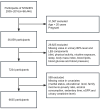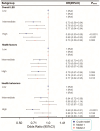The Adverse Impact of Bisphenol A Exposure on Optimal Cardiovascular Health as Measured by Life's Essential 8 in U.S. Adults: Evidence from NHANES 2005 to 2016
- PMID: 39408220
- PMCID: PMC11478777
- DOI: 10.3390/nu16193253
The Adverse Impact of Bisphenol A Exposure on Optimal Cardiovascular Health as Measured by Life's Essential 8 in U.S. Adults: Evidence from NHANES 2005 to 2016
Abstract
Background/Objectives: Cardiovascular diseases are the primary cause of global morbidity and mortality, with cardiovascular health (CVH) remaining well below the ideal level and showing minimal improvement in the U.S. population over recent years. Bisphenol A (BPA), a pervasive environmental contaminant, has emerged as a potential contributor to adverse cardiovascular outcomes. This cross-sectional study delves into the impact of BPA exposure on achieving optimal CVH, as assessed by the Life's Essential 8 metric, among U.S. adults. Methods: Analyzing data from 6635 participants in the National Health and Nutrition Examination Survey (NHANES) collected between 2005 and 2016, BPA exposure was quantified through urinary BPA levels, while optimal CVH was defined using the American Heart Association's Life's Essential 8 criteria, scoring between 80 and 100. Multivariable logistic regression and propensity score matching were employed to evaluate the association between BPA exposure and CVH. Results: This study reveals that individuals in the highest tertile of urinary BPA levels were 27% less likely to attain optimal CVH compared with those in the lowest tertile (OR, 0.73; 95% CI: 0.59-0.92). This negative association persisted across diverse demographics, including age, sex, and race, mirrored in the link between urinary BPA levels and health factor scores. Conclusions: The findings underscore the potential benefits of reducing BPA exposure in enhancing the prevalence of optimal CVH and mitigating the burden of cardiovascular disease. Given the widespread use of BPA, ongoing monitoring of BPA's impact on CVH is essential. Further studies are necessary to elucidate the long-term and causative connections between BPA and CVH. These insights contribute to understanding the complex interplay between environmental factors and CVH outcomes, informing targeted interventions to mitigate cardiovascular disease risk within the population.
Keywords: Life’s Essential 8; NHANES; bisphenol A; cardiovascular disease; cardiovascular health; environmental exposure.
Conflict of interest statement
The authors declare no conflicts of interest.
Figures





Similar articles
-
Association of the American Heart Association's new "Life's Essential 8" with all-cause and cardiovascular disease-specific mortality: prospective cohort study.BMC Med. 2023 Mar 29;21(1):116. doi: 10.1186/s12916-023-02824-8. BMC Med. 2023. PMID: 36978123 Free PMC article.
-
Temporal trends in bisphenol A exposure in the United States from 2003-2012 and factors associated with BPA exposure: Spot samples and urine dilution complicate data interpretation.Environ Res. 2015 Oct;142:84-95. doi: 10.1016/j.envres.2015.06.013. Epub 2015 Jun 26. Environ Res. 2015. PMID: 26121292
-
Bisphenol A and peripheral arterial disease: results from the NHANES.Environ Health Perspect. 2012 Sep;120(9):1297-300. doi: 10.1289/ehp.1104114. Epub 2012 May 29. Environ Health Perspect. 2012. PMID: 22645278 Free PMC article.
-
Dose-response associations of the American Heart Association's new "Life's essential 8" metrics with all-cause and cardiovascular mortality in a nationally representative sample from the United States.Prog Cardiovasc Dis. 2024 Jul-Aug;85:31-37. doi: 10.1016/j.pcad.2024.06.001. Epub 2024 Jun 24. Prog Cardiovasc Dis. 2024. PMID: 38925257 Review.
-
Cardiovascular Health Disparities in Adults of Color Aged 18 to 50: A Systematic Review.J Cardiovasc Nurs. 2025 May-Jun 01;40(3):258-267. doi: 10.1097/JCN.0000000000001165. Epub 2024 Nov 29. J Cardiovasc Nurs. 2025. PMID: 39620645 Free PMC article.
Cited by
-
Using Life's Essential 8 and heavy metal exposure to determine infertility risk in American women: a machine learning prediction model based on the SHAP method.Front Endocrinol (Lausanne). 2025 Jul 4;16:1586828. doi: 10.3389/fendo.2025.1586828. eCollection 2025. Front Endocrinol (Lausanne). 2025. PMID: 40687585 Free PMC article.
References
-
- Roth G.A., Mensah G.A., Johnson C.O., Addolorato G., Ammirati E., Baddour L.M., Barengo N.C., Beaton A.Z., Benjamin E.J., Benziger C.P., et al. Global burden of cardiovascular diseases and risk factors, 1990–2019: Update from the GBD 2019 study. J. Am. Coll. Cardiol. 2020;76:2982–3021. doi: 10.1016/j.jacc.2020.11.010. - DOI - PMC - PubMed
-
- Lloyd-Jones D.M., Allen N.B., Anderson C.A.M., Black T., Brewer L.C., Foraker R.E., Grandner M.A., Lavretsky H., Perak A.M., Sharma G., et al. Life’s essential 8: Updating and enhancing the American heart association’s construct of cardiovascular health: A presidential advisory from the American heart association. Circulation. 2022;146:e18–e43. doi: 10.1161/CIR.0000000000001078. - DOI - PMC - PubMed
-
- Lloyd-Jones D.M., Hong Y., Labarthe D., Mozaffarian D., Appel L.J., Van Horn L., Greenlund K., Daniels S., Nichol G., Tomaselli G.F., et al. Defining and setting national goals for cardiovascular health promotion and disease reduction: The American heart association’s strategic impact goal through 2020 and beyond. Circulation. 2010;121:586–613. doi: 10.1161/CIRCULATIONAHA.109.192703. - DOI - PubMed
-
- Younus A., Aneni E.C., Spatz E.S., Osondu C.U., Roberson L., Ogunmoroti O., Malik R., Ali S.S., Aziz M., Feldman T., et al. A systematic review of the prevalence and outcomes of ideal cardiovascular health in US and non-US populations. Mayo Clin. Proc. 2016;91:649–670. doi: 10.1016/j.mayocp.2016.01.019. - DOI - PubMed
MeSH terms
Substances
LinkOut - more resources
Full Text Sources

